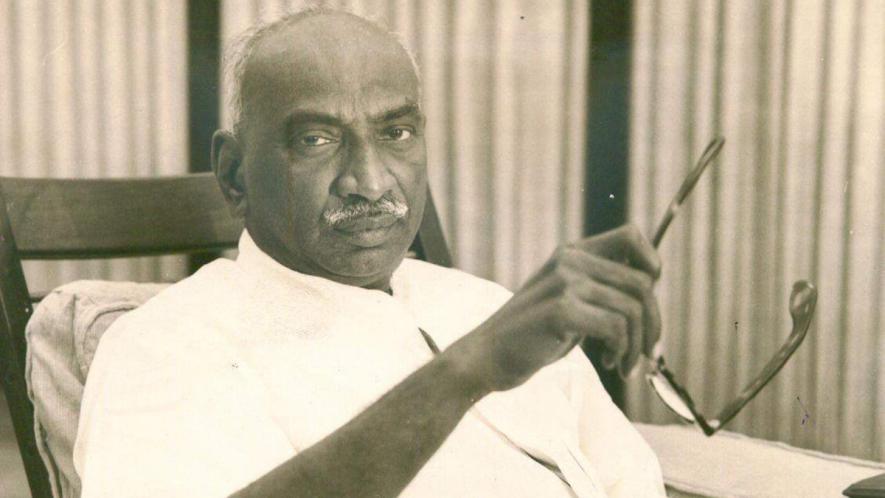Why BJP's Promise of 'Kamarajar Aatchi' in TN Reeks of Duplicity

Image Courtesy: Wikimedia Commons
The ruling Bharatiya Janata Party's political rhetoric has in recent years made attempts to appropriate icons from outside the Hindutva fold. In its attempts to gain more acceptability, legitimacy and create political capital, the party has, in a politically expedient manner, co-opted leaders and icons from across the aisle.
The BJP's perennial search for icons has seen it misappropriating figures from broadly two categories; the first category consists of figures who are strong symbols of regional pride. As a party that subscribes to the more rigid, unitary notion of nationalism, batting for 'Hindi, Hindu, Hindustan', the BJP has struggled to appeal to the states' electorate where the regional sentiment is strong. To gain a toehold in such regions, the party has appropriated icons with a strong regional appeal. The BJP's scramble to invoke and stake a claim to the legacies of figures like Rabindranath Tagore in Bengal and MG Ramachandran in Tamil Nadu was a part of the same strategy.
The other category includes leaders and figures neglected or sidelined by the BJP's arch-rival, the Congress. The list of 'estranged Congressmen' or Congress leaders, who were denied their due by the party and then targeted by the BJP, is long and includes the likes of Sardar Vallabhai Patel, PV Narsimha Rao, Netaji Subhash Chandra Bose, and Jayaprakash Narayan.
The latest in the line of leaders whose legacy the BJP has attempted to appropriate is Congress stalwart and former Tamil Nadu Chief Minister Kumaraswami Kamaraj. In a state where the saffron party has failed to get going and struggled to shrug off the 'North Indian Brahminical' tag, the BJP has resorted to its politics of borrowing regional icons. In an attempt to shed its 'outsider' tag, the saffron party has set its eyes on figures like Jayalalithaa, MGR and Kamaraj. In the run-up to the assembly elections, the BJP used life-size cutouts of MGR and Kamaraj in Prime Minister Narendra Modi's Coimbatore rally.
But the BJP's attempts to claim Kamaraj and his legacy did not begin with the 2021 state assembly polls. As early as 2015, the party had set its sight on Kamaraj. That year, on the revered leader's birth anniversary, fondly called Perunthalaivar, the then Union Minister M Venkaiah Nadu while paying rich tributes to Kamaraj, had drawn parallels between the former Madras state CM and PM Modi. He also expressed the BJP's desire to take Kamaraj's vision and legacy forward. In 2018, the BJP and Congress workers in the state came close to exchanging blows while attempting to stake a claim to Kamaraj's legacy during his birth anniversary celebrations.
On paper, the BJP's efforts to appropriate Kamaraj makes a lot of political sense. By seeking to appropriate him, the party is also trying to consolidate and build on the support it enjoys among the Hindu Nadars in the southern and western parts of the state. Furthermore, Kamaraj, who continues to be celebrated by the state's rural folk, is the perfect choice for the BJP. He is the tallest leader representing the non-Dravidian school of politics in a state where the Dravidian parties have established their hegemony over the last five decades. At the national level, in Kamaraj, the BJP sees another anti-Gandhi family mascot whose tumultuous and strained relationship with Indira Gandhi can be used to attack the first family of the Congress.
Kamaraj, the Architect of Modern Tamil Nadu
Outside Tamil Nadu, Kamaraj is primarily remembered as the kingmaker who installed two prime ministers -- Lal Bahadur Shashtri and Indira Gandhi. He deftly dealt with the contrasting ambitions of Congress leaders eyeing the chair during the twin power struggles that followed Nehru's death in 1964 and Shahstri's demise in 1966. He is hailed as the 'architect of Modern Tamil Nadu' and continues to command respect and awe in his home state. Several stories and legends about the man's honesty, probity, and empathy for the week, political astuteness and administrative acumen have made Kamaraj a semi-mythical figure of sorts.
The phrase Kamarajar Aatchi (Kamaraj's rule), often used to remind one of Kamaraj's Chief Ministerial years, is used in the same sense as the term Ram Rajya is in the states lying to the north of the Vindhyas. During his nine-year-long stint as Tamil Nadu's second chief minister, Kamaraj was responsible for ushering in a slew of reforms that laid the educational and industrial foundations of the state.
Kamaraj took over the reins from C. Rajagopalachari under testing times. In 1951, the literacy rate for the state of Madras was a measly 20%, only half of the school-going age children were enrolled, and 60% of those enrolled were likely to drop out before completing five years. Instead of increasing government spending on primary education, the fiscally conservative Rajaji's response to the problem was the Modified Scheme of Elementary Education; the policy halved the school day for children aged between six and eleven. It proposed introducing two shifts or sessions in elementary schools to double the intake of students. In the first session, the students were to go to schools where they would receive regular teaching, and in the other session, they were sent back to gain training in their parent's occupation. Not surprisingly, Rajaji's contentious scheme faced stiff resistance and sparked massive outrage. Critics of the project lashed out at the new scheme's validation of the caste system by calling it the Kala Kulvi Thitham (caste-based education policy). An obstinate Rajaji who was unwilling to withdraw the scheme had to make way for Kamaraj.
Kamaraj had his task cut out as the odds were stacked heavily against him. But he wasted no time in scrapping Rajaji's controversial scheme. Once the Kala Kulvi Thitham was dumped in the bin, Kamaraj, a class six dropout, decided to overhaul the state's existing education policy completely. In 1955, the Kamaraj administration extended the free education scheme to needy students whose parents earned less than Rs 100 a month. The fee concession scheme, which halved the school fees for children of backward classes and economically weaker government servants, was extended to all students across the state. He also scrapped the clause restricting students retained in the same standard for consecutive years from availing the fees concession.
During his years in power, the government opened over 12,000 new schools, most of them in remote and rural areas of the state. When a survey conducted in 1957 revealed that over 6,000 villages across the state had no schools, Kamaraj undertook an ambitious mission to expand schools. Within the next four years, the government constructed over 4,000 new schools and appointed around 6,000 unemployed graduates as teachers. Under Kamaraj, Tamil Nadu achieved the feat of becoming the first state in the country to have a primary school every three kilometres and a high school every five kilometres. The percentage of school-going children in the 6-11 years age group increased from 45 to 75 within seven years of Kamaraj assuming the CM's chair.
To ensure a higher enrollment rate in schools and reduce the dropout rate, Kamaraj pioneered the midday meal scheme, which became his government's most well-known and widely lauded initiative. The concept of providing free midday meals to boost enrollment in schools was not entirely new to Tamil Nadu as it had existed in some form since the time of the Justice Party in the 1920s. The scheme had been tried and tested, even tweaked on multiple occasions, only to be ditched due to financial constraints. But in 1957, Kamaraj decided to throw the entire weight of his government behind the scheme as he was convinced that the goal of universal education could not be satisfied without catering to the hunger pangs of poor children. While the government bore about 60% of the expenditure, the rest was taken care of by the general public and even some private players. Citizens were also encouraged to donate rice and pulses towards the project.
At the time of the scheme's launch, it covered around 8,000 of the state's 22,000-odd schools. The government gradually expanded the scheme in a planned, phase-wise manner to cover all schools in the rural areas of the state. By 1961, the scheme covered almost 97% of the schools across the state, feeding about 13 lakh children enrolled in these schools. Kamaraj successfully roped in international players like the American International Voluntary Organization to cover schools in the urban areas. As Chief Minister, MGR would expand the scope and reach of the midday meal scheme. In the years to come, state governments across the country would launch their own midday meal schemes following Kamaraj's footsteps.
Kamaraj's contributions towards strengthening Tamil Nadu's public education system earned him the title of 'Kalavi Vallal' (Benevolent Educator).
Kamaraj's other major feat was his role in laying the foundations of modern Tamil Nadu's industrial progress. A massive rural electrification campaign was launched to give impetus to the agricultural sector. The power generation capacity of the state doubled from 220 MW in 1954 to 460 MW in 1963. By the time Kamaraj resigned as the Chief Minister to move to Delhi, the state had ranked number one in India in both urban and rural electrification.
Central Public Sector Units (PSUs) like Integral Coach Factory, BHEL, Neyveli Lignite Corporation, Hindustan Teleprinter and Hindustan Film Workshop-all came up during the Kamaraj years. To ensure that industries do not get concentrated in a particular region of the state, consequently sowing the seeds of resentment in other areas of the state, Kamaraj cautiously took efforts to spread them across the state. More than nine industrial zones in different parts of the state employed skilled and unskilled workers and laid the solid basis for the emergence of Tamil Nadu as an industrial powerhouse.
BJP's Attempts to Appropriate Kamaraj
In the past few years, BJP leaders, especially those belonging to the party's state unit, have praised Kamaraj on several occasions and even reiterated the party's promise of bringing back Kamarajar Aatchi or Kamaraj's rule. One cannot help but notice the irony. The most striking feature of Kamaraj's administration was opening schools, colleges, and educational institutions in remote towns and villages, both big and small, to make education genuinely universal.
This principle of "universal education" or "making education accessible for all" has been religiously followed by successive state governments in Tamil Nadu, regardless of party affiliations. A large part of the credit for the success of the state's sound public education system goes to the government's commitment to making education accessible to every single student, even those residing in remote, rural areas; all of it began during the Kamaraj years.
While on the one hand, the BJP has been promising to bring back Kamarajar Aatchi, the Centre's New Education Policy (NEP 2020) proposes to do the exact opposite. The NEP, which aims to create a highly centralised education system, is entirely against the idea of "numerous small schools" - a key component of Kamaraj's much successful education policy. The NEP states that it wants to end "fragmentation of higher education by transforming higher education institutions into large multidisciplinary universities with 3,000 or more students." This also explains why Tamil Nadu has been fighting against the NEP's implementation. If implemented, the policy would force the state to do away with its proven formula of making education accessible and universal through small education institutes in remote regions.
Several middle-rung BJP leaders have often drawn parallels between Kamaraj and PM Modi, claiming that the prime minister is following the Tamil Nadu stalwart's footsteps in many ways. Here too, there is a mismatch between the BJP's words and actions.
In its high decibel campaign against the UPA II in 2014, the Modi-led BJP had used a catchy slogan - "minimum government, maximum governance." The slogan instantly struck a chord with the electorate.
Seven years later, the slogan seems to have been forgotten. PM Modi's council of ministers is now even bigger than UPA-II and has 77 members, just four shy of the permissible limit of 81. But much before the BJP wooed the voters with the promise of "minimum government, maximum governance" to apparently root out inefficiency and corruption, someone else had already delivered on the promise -- Kumaraswamy Kamaraj. The ministry with which Kamaraj laid the foundations of modern-day Tamil Nadu never consisted of more than nine ministers.
When Kamaraj was first sworn in as the Chief Minister, he surprised everyone with his decision to include M Bhaktavatsalam and C Subramaniam in his eight-member ministry. C Subramaniam was a staunch Rajaji loyalist and a known Kamaraj critic within the Congress state unit. On the other hand, M Bhaktavatsalam, a former supporter of Kamaraj, had turned against him and even suggested Subramaniam's name for the top job after Rajaji's resignation. Furthermore, Kamaraj handed C Subramaniam the crucial portfolios of finance and education. Contrast this with the BJP and its top leadership, which claims to be following Kamaraj's footsteps while being accused of snooping on its own cabinet ministers by using foreign spyware.
In 2019, kicking off the BJP's campaign during the Lok Sabha elections in Tamil Nadu, Narendra Modi had hit out at the Gandhi family for insulting Kamaraj. Over the years, BJP leaders have not missed a single opportunity to take a potshot at the grand old party's first family, reminding them of the strained equation between Indira Gandhi and K. Kamaraj. The BJP seems to be suffering from selective amnesia -- conveniently remembering the historical bits that provide enough ammunition to target the Congress and forgetting the not-so-convenient bits.
In the last few years of his life, Kamaraj did come close to merging his Congress (O) with Indira's Congress. In fact, the factions had even formed alliances to contest the Puducherry Assembly election in 1974 and the Coimbatore Assembly and Parliamentary bypolls. But with the imposition of the Emergency and the arrest of opposition leaders, Kamaraj made it clear that the efforts for a merger can only begin after the government had lifted the Emergency and released arrested leaders. Even the otherwise obstinate Indira showed signs of being willing to yield ground, but nothing could materialise due to the untimely demise of Kamaraj in October 1975.
Today, the BJP has no qualms in attempting to appropriate Kamaraj and his legacy while embarrassing the Congress with a few history lessons. But it is baffling that the party has conveniently forgotten how in 1966, an angry, fanatical mob comprising members of various pro-Hindutva groups demanding a ban on cow slaughter had attacked and set Kamaraj's Delhi residence on fire. The BJP's predecessor, the Bhartiya Jan Sangh (BJS), had not only been one of the many organisations that had voiced its support for the anti-cow slaughter movement but many BJS members were also actively involved in it.
But the BJP's cherry-picking of historical facts is nothing new, and it is now a vital component of the party's politics of borrowing. Hence, it is here to stay for a long time.
The author is a freelancer based in Bombay and an alumnus of Mumbai’s St. Xavier’s College. His interests vary from politics, psephology, and journalism to regional Indian cinema. He tweets @Omkarismunlimit
Get the latest reports & analysis with people's perspective on Protests, movements & deep analytical videos, discussions of the current affairs in your Telegram app. Subscribe to NewsClick's Telegram channel & get Real-Time updates on stories, as they get published on our website.























